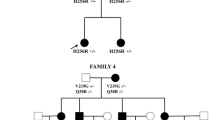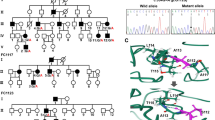Abstract
Mutations in the SH3TC2 gene cause Charcot–Marie–Tooth disease type 4C (CMT4C), characterized by inherited demyelinating peripheral neuropathy. CMT4C is a common form of CMT4/autosomal recessive (AR) CMT1. This study examined the SH3TC2 variants, investigated genotype–phenotype correlations and explored the frequency of CMT4C in Chinese patients. A total of 206 unrelated patients of Chinese Han descent clinically diagnosed with CMT were recruited. All patients underwent detailed history-taking, neurological examination, laboratory workups, and electrophysiological studies. Genetic analysis was performed via high-throughput target sequencing (NGS). Three patients, one male and two females, were found to carry five SH3TC2 mutations: patient 1 (c.3154C > T, p.R1054X; c.929G > A, p.G310E); Patient 2 (c.2872_2872del, p.S958fs; c.3710C > T, p.A1237V) and Patient 3 (c.2782C > T, p.Q928X; c.929G > A, p.G310E). The c.2872_2872del, c.3710C > T and c.2782C > T variants were not reported before. CMT4C caused by SH3TC2 mutation is a very common type of CMT4/AR CMT1. Three novel mutations, c.2872_2872del, c.3710C > T and c.2782C > T, were found in this study. Combination of clinical phenotype, nerve conduction studies, genetic analysis and bioinformatics analysis are of vital importance in patients suspected as CMT.



Similar content being viewed by others
References
Sun B, Chen Z, Ling L et al (2017) Clinical and genetic spectra of Charcot-Marie-Tooth disease in Chinese Han patients [J]. J Peripher Nerv Syst 22(1):13–18. https://doi.org/10.1111/jns.12195 (PMID:27862672)
Sun B, Chen ZH, Ling L et al (2016) Mutation analysis of gap junction protein Beta 1 and genotype-phenotype correlation in X-linked Charcot-Marie-Tooth disease in Chinese patients [J]. Chin Med J 129(9):1011–1016. https://doi.org/10.4103/0366-6999.180511 (PMID:27098783)
Szigeti K, Lupski JR (2009) Charcot-Marie-Tooth disease. Eur J Hum Genet 17(6):703–710. https://doi.org/10.1038/ejhg.2009.31
Pareyson D (1999) Charcot-Marie-Tooth disease and related neuropathies: molecular basis for distinction and diagnosis. Muscle Nerve 22(11):1498–1509. https://doi.org/10.1002/(sici)1097-4598(199911)22:11%3c1498::aid-mus4%3e3.0.co;2-9
Gentile L, Russo M, Fabrizi GM et al (2020) Charcot-Marie-Tooth disease: experience from a large Italian tertiary neuromuscular center. Neurol Sci 41(5):1239–1243. https://doi.org/10.1007/s10072-019-04219-1
Lupo V, Galindo MI, Martínez-Rubio D et al (2009) Missense mutations in the SH3TC2 protein causing Charcot-Marie-Tooth disease type 4C affect its localization in the plasma membrane and endocytic pathway. Hum Mol Genet 18(23):4603–4614. https://doi.org/10.1093/hmg/ddp427
Reilly MM, Shy ME (2009) Diagnosis and new treatments in genetic neuropathies. J Neurol Neurosurg Psychiatry 80(12):1304–1314. https://doi.org/10.1136/jnnp.2008.158295
Laššuthová P, Mazanec R, Vondráček P et al (2011) High frequency of SH3TC2 mutations in Czech HMSN I patients. Clin Genet 80(4):334–345. https://doi.org/10.1111/j.1399-0004.2011.01640.x
Yuan JH, Hashiguchi A, Okamoto Y et al (2018) Clinical and mutational spectrum of Japanese patients with recessive variants in SH3TC2. J Hum Genet 63(3):281–287. https://doi.org/10.1038/s10038-017-0388-5
Arnaud E, Zenker J, de Preux Charles AS et al (2009) SH3TC2/KIAA1985 protein is required for proper myelination and the integrity of the node of Ranvier in the peripheral nervous system. Proc Natl Acad Sci USA 106(41):17528–17533. https://doi.org/10.1073/pnas.0905523106
Roberts RC, Peden AA, Buss F et al (2010) Mistargeting of SH3TC2 away from the recycling endosome causes Charcot-Marie-Tooth disease type 4C. Hum Mol Genet 19(6):1009–1018. https://doi.org/10.1093/hmg/ddp565
Yger M, Stojkovic T, Tardieu S et al (2012) Characteristics of clinical and electrophysiological pattern of Charcot-Marie-Tooth 4C. J Peripher Nerv Syst 17(1):112–122. https://doi.org/10.1111/j.1529-8027.2012.00382.x
Manganelli F, Tozza S, Pisciotta C et al (2014) Charcot-Marie-Tooth disease: frequency of genetic subtypes in a Southern Italy population. J Peripher Nerv Syst 19(4):292–298. https://doi.org/10.1111/jns.12092
Rudnik-Schöneborn S, Tölle D, Senderek J et al (2016) Diagnostic algorithms in Charcot-Marie-Tooth neuropathies: experiences from a German genetic laboratory on the basis of 1206 index patients. Clin Genet 89(1):34–43. https://doi.org/10.1111/cge.12594
Lee AJ, Nam SH, Park J-M et al (2019) Compound heterozygous mutations of SH3TC2 in Charcot–Marie–Tooth disease type 4C patients. J Hum Genet 64:961–965. https://doi.org/10.1038/s10038-019-0636-y
Piscosquito G, Saveri P, Magri S et al (2016) Screening for SH3TC2 gene mutations in a series of demyelinating recessive Charcot-Marie-Tooth disease (CMT4). J Peripher Nerv Syst 21(3):142–149. https://doi.org/10.1111/jns.12175
DiVincenzo C, Elzinga CD, Medeiros AC et al (2014) The allelic spectrum of Charcot-Marie-Tooth disease in over 17,000 individuals with neuropathy. Mol Genet Genomic Med 2(6):522–529. https://doi.org/10.1002/mgg3.106
Nam SH, Hong YB, Hyun YS et al (2016) Identification of genetic causes of inherited peripheral neuropathies by targeted gene panel sequencing. Mol Cells 39(5):382–388. https://doi.org/10.14348/molcells.2016.2288
Murphy SM, Herrmann DN, McDermott MP et al (2011) Reliability of the CMT neuropathy score (second version) in Charcot-Marie-Tooth disease. J Peripher Nerv Syst 16(3):191–198. https://doi.org/10.1111/j.1529-8027.2011.00350.x
Lee AJ, Nam SH, Park JM et al (2019) Compound heterozygous mutations of SH3TC2 in Charcot-Marie-Tooth disease type 4C patients. J Hum Genet 64(9):961–965. https://doi.org/10.1038/s10038-019-0636-y
Forrester N, Rattihalli R, Horvath R et al (2020) Clinical and genetic features in a series of eight unrelated patients with neuropathy due to Glycyl-tRNA synthetase (GARS) variants. J Neuromuscul Dis 7(2):137–143. https://doi.org/10.3233/JND-200472
Senderek J, Bergmann C, Stendel C et al (2003) Mutations in a gene encoding a novel SH3/TPR domain protein cause autosomal recessive Charcot-Marie-Tooth type 4C neuropathy. Am J Hum Genet 73(5):1106–1119. https://doi.org/10.1086/379525
Azzedine H, Ravisé N, Verny C et al (2006) Spine deformities in Charcot-Marie-Tooth 4C caused by SH3TC2 gene mutations. Neurology 67(4):602–606. https://doi.org/10.1212/01.wnl.0000230225.19797.93
Funding
The study is financially supported by National Natural Science Foundation of China: The study of long non-coding RNA in the pathogenesis of CMT1A (81870989) and the study of mitochondrial unfolded protein response in the pathogenesis of CMT1B (81901274).
Author information
Authors and Affiliations
Corresponding author
Ethics declarations
Conflict of interest
There are no conflicts of interest.
Ethical approval
The study was approved by the Chinese PLA General Hospital Ethics Committee. Informed written consent was obtained from all the patients enrolled in this study.
Additional information
Publisher's Note
Springer Nature remains neutral with regard to jurisdictional claims in published maps and institutional affiliations.
Rights and permissions
About this article
Cite this article
Sun, B., He, ZQ., Li, YR. et al. Screening for SH3TC2 variants in Charcot–Marie–Tooth disease in a cohort of Chinese patients. Acta Neurol Belg 122, 1169–1175 (2022). https://doi.org/10.1007/s13760-021-01605-5
Received:
Accepted:
Published:
Issue Date:
DOI: https://doi.org/10.1007/s13760-021-01605-5




